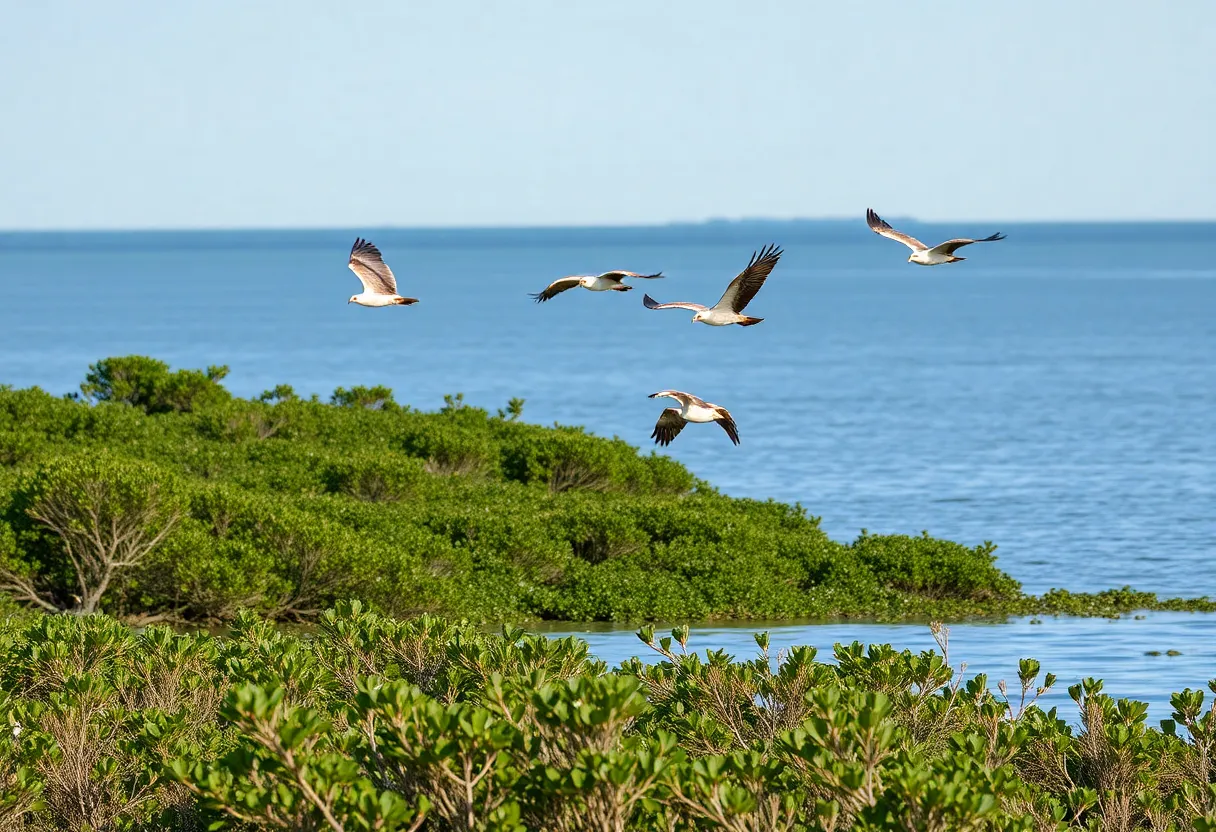News Summary
Conservationists report a significant decline in the osprey population in Chesapeake Bay due to overfishing of menhaden, a key food source. Biologist Bryan Watts has observed alarming rates of failed breeding among ospreys. Recent studies indicate that many pairs are producing less than the necessary number of chicks, raising concerns about malnutrition. The fishing industry disputes the link, attributing issues to climate change and pollution. Proposed management strategies aim to balance fishing practices with conservation to protect ospreys.
Chesapeake Bay, Virginia – A significant decline in the osprey population in the Chesapeake Bay has been noted and is closely connected to the overfishing of menhaden, according to conservationists and biologists. Bryan Watts, a biologist from the College of William & Mary’s Center for Conservation Biology, has reported patterns of failed osprey nesting across Virginia’s renowned bay area. Ospreys, which are bird species famous for their adept diving abilities, primarily depend on menhaden, a small yet vital schooling fish, for their diet.
The current rates of successful osprey breeding in the Chesapeake Bay have raised alarms within the conservation community. To sustain a healthy population, ospreys need to raise an average of 1.15 chicks per pair each year, but recent data shows that many breeding pairs are producing less than half that number. This alarming statistic has prompted further investigation into the underlying causes of this decline, with Watts attributing it significantly to decreasing menhaden populations. The scarcity of this essential food source has been leading to malnutrition and starvation among osprey chicks.
Federal data aligns with these concerns, indicating a troubling trend of declining breeding success among ospreys nationwide, regardless of other contributing factors to the decline. This situation highlights the urgent need for addressing the relationship between menhaden fishing practices and the health of the osprey population.
Industry Response
The fishing industry, represented by companies like Omega Protein, contests claims that the decline in osprey numbers is directly due to overfishing of menhaden. Industry representatives attribute the problem to multiple factors, such as climate change and pollution affecting fish stocks and habitats. As the menhaden fishery remains a key industry in the region, valued at over $200 million in 2023, maintaining a balance between fishing practices and conservation efforts is crucial.
A recent survey conducted in May 2025 reported a staggering 90% decrease in nesting osprey populations on the Delmarva Peninsula, a situation attributed to the limited availability of essential prey like menhaden. This drop has sparked renewed discussions about the methods used in industrial fishing, particularly the necessity for precautionary management strategies and comprehensive assessments regarding menhaden harvesting practices.
Management Proposals
In response to these pressing issues, new management proposals for the menhaden fishery have emerged. These proposals include potential seasonal closures, stricter fishing quotas, and regulations on the gear used for fishing to ensure that the menhaden population can recover. Given the ongoing decline in osprey numbers, such management strategies are deemed essential to prevent further jeopardization of this iconic bird species.
Historical Context
The history of the osprey population offers critical context to the current situation. Ospreys experienced drastic declines in the past, particularly during the era of DDT use, which severely impacted various bird species. Thankfully, following the ban on DDT in 1972, ospreys saw a recovery. However, conservationists from the Chesapeake Bay Foundation warn that if immediate actions are not taken concerning menhaden fishing practices, a repeat of historical declines could occur.
Regarding the direct relationship between menhaden availability and osprey reproductive performance, conservationists argue that the two are indeed deeply intertwined. Nevertheless, some critics express skepticism about the studies focusing on the correlations between menhaden populations and osprey breeding success. They argue that there is insufficient localized evidence to draw definitive conclusions about the impacts of overfishing on the osprey population.
As the debate continues, the imperative remains clear: immediate and effective action is needed to address the decline of ospreys in the Chesapeake Bay, particularly concerning fishing practices surrounding menhaden, in order to secure a future for this magnificent bird species.
Deeper Dive: News & Info About This Topic
HERE Resources
Declining Osprey Fertility Rates Linked to Menhaden Shortage
Declining Osprey Nest Success Linked to Menhaden Shortage
Chesapeake Bay Osprey Population Decline Linked to Menhaden Shortage
Virginia Ospreys Face Decline Due to Menhaden Shortage and New Nesting Threats
Declining Osprey Populations in Virginia’s Chesapeake Bay
Additional Resources
- WTVR: Menhaden Overfishing and Osprey Nests
- Bay Journal: Osprey Chicks Starve
- WBOC: Osprey Population Collapse in Virginia
- Washington Post: Chesapeake Bay Ospreys
- Bay Journal: Osprey Troubles Not Tied to Menhaden

Author: STAFF HERE VIRGINIA BEACH WRITER
The VIRGINIA BEACH STAFF WRITER represents the seasoned team at HEREVirginiaBeach.com, your trusted source for actionable local news and information in Virginia Beach, Virginia Beach City, and beyond, delivering "news you can use" with comprehensive coverage of product reviews for personal and business needs, local business directories, politics, real estate trends, neighborhood insights, and state news impacting the region—supported by years of expert reporting and strong community input, including local press releases and business updates, while offering top reporting on high-profile events like the Virginia Beach Neptune Festival, East Coast Surfing Championship, and military homecoming celebrations, alongside key organizations such as the Virginia Aquarium, Virginia Beach Convention Center, and Oceana Naval Air Station, plus leading businesses in tourism and defense like Busch Gardens and Northrop Grumman, and as part of the broader HERE network including HEREWilliamsburg.com, providing credible, in-depth insights into Virginia's vibrant landscape. HERE Virginia Beach HERE Williamsburg





